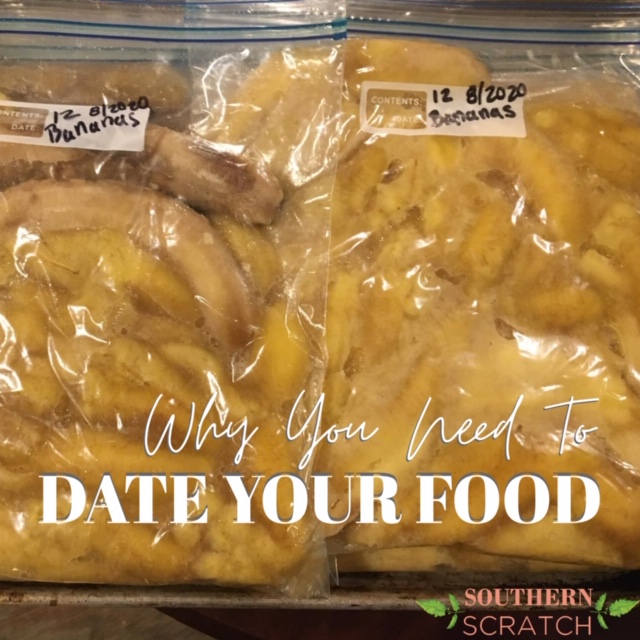
Sep 14, 2020
Why You Need to Date Your Food
In our home I do the majority of the grocery shopping, meal prep and cooking. This means that I pretty much have it all in my head what food is good, what needs to be used up ASAP and what needs to be tossed before it starts growing a rain forest. If I was the only one living here it would be fine if this stayed in my head. The problem is that four other people live here and I’m also lucky to have friends that I totally trust to take charge of my kitchen as well.
When I had the shop, there were more than four people handling food as well and everyone needed to be on the same page to know not just what the food was but also when it was opened or prepared in order for the food to be used up or thrown away before it went bad.
It may seem like overkill to label and date your food in your own home but if you set up a simple system it becomes second nature and you will wonder why you’ve never done it before. In the drawer beside my fridge I have a small food labeling section. It has blank white sticky labels with a pen/pencil as well as permanent markers and dry erase markers. These get used for other purposes as well but I keep them all in this one spot in the drawer next to the refrigerator.
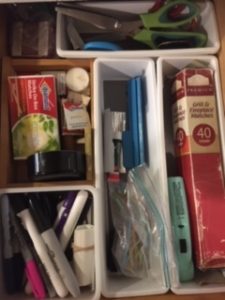
This used to be a junk drawer but then I hired a professional organizer and learned the secret of drawer dividers.
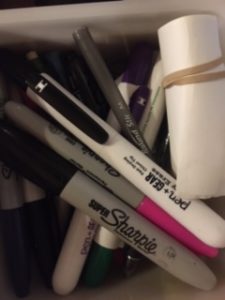
Food dating/labeling supplies-white sticky labels, pen/pencil, dry erase markers and permanent markers. Kept right beside the fridge for easy access.
Blank white sticky labels-These will go on top of plastic wrap that I couldn’t write directly on top of. I can write on the label flat and then stick on. They are also good for food I’m bringing to somebody because I can write reheating directions on them.
Permanent Marker-I use this for anything we vacuum seal and then put in the freezer so it doesn’t rub off. When we process venison during hunting season I may also write the total weight of the meat on it as well along with the cut.
Dry Erase Marker-This is perfect for plastic or even glass food storage containers. It wipes off easily so you may want to write on the side that’s not going to have anything stacked on top of it.
Chalk Marker- This isn’t something that I use, but if you tend toward black storage containers or do meal prepping, these will work the same way as the dry erase markers but stand out on the side. It could also be a more festive way to send someone home with leftovers.
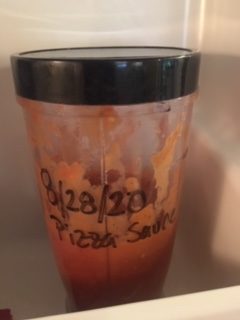
Pizza sauce made in a bullet blender and dry erase marker used to date. Wipes off easily or comes off when washed.
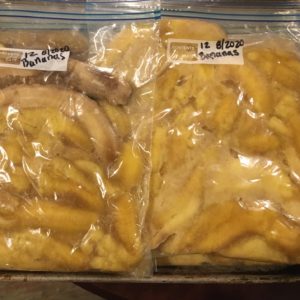
For use in recipes, consider adding the amount or number when labeling as well. I have a huge banana bread recipe that takes a dozen bananas so I know I can just pull out one bag of these to make it.
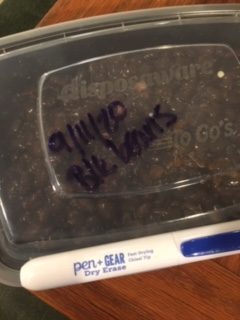
Dry erase marker on top of plastic disposable containers with description. (Black beans)
Benefits of labeling your food:
-The most obvious reason is so that you remove (or reduce) the chance that someone in your house is going to eat spoiled food by having a date on it. If it’s anywhere past a week old, definitely toss it. Some things have shorter shelf lives but you won’t remember if you don’t have a date on it-even if you think you will, trust me. One time I accidentally sent Reid to work with two-three week old tamales and it took a loooong time for him to trust me again. It’s still a running joke.
-Having a date encourages you to “use it or lose it” when it comes to leftovers which can help reduce food waste and food costs.
-In a household, dating and labeling of food is a way to communicate even when the other person isn’t there. I’ve virtually eliminated being asked “What’s this?”
-If you live with others, you can truly unload food responsibilities which can be a step toward more equitable parenting. In my experience, one of the biggest barriers to having help cooking meals or feeding is having to explain what food we have on hand. I feel like if I have to walk someone through the fridge and pantry pointing out which food is good or what isn’t, I may as well just fix lunch myself. By having the opened food or leftovers dated and labeled, my husband doesn’t need to ask if an item is still good or not. Using our meal template also makes it easier to more evenly distribute workload in the kitchen. On Saturdays, our template says “Reid’s Choice” and on Sundays we have “Sandwiches at the Creek.” I don’t even grocery shop for these meals anymore nor do I feel the burden of planning for them.
-It keeps your refrigerator cleaned out. I once read a book that described why clothes that are worn once or just tried on often get piled on top of chairs or couches in a bedroom. The reason is that the clothes aren’t dirty enough to actually wash again but they’re also not clean enough to go back in the closet. If you’re stuck in this all or nothing or dichotomous thinking, you end up with a chair full of “grey” or not black and white or not 100% clean or dirty clothes pile. I think it can be the same with food. Sometimes it’s a little hazy whether it’s “fresh enough” to still eat or “bad enough” to actually throw away for good. Putting a date on your food makes your decision to toss or not black and white. If it’s within seven days or less of being opened or prepared-keep it. If it’s not, toss it. The longer it sits there the grosser it will be to throw away or wash.
If you’re on the fence about whether food realllllyyy goes bad by the expiration date, go watch all the salmonella or botulism videos you need to to convince yourself that food safety is important and then, and I know that this is unsolicited advice-date your food!

You can even write cooking instructions on freezer bags with a permanent marker so you don’t have to look up the recipe.
